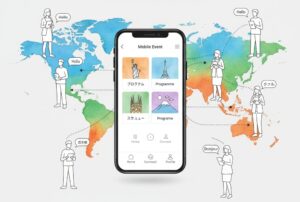In-Person Events Are Going to Look Different: Your Guide to Going Back
The pandemic has introduced a whole variety of changes to our workplace.
From online-based work from home during the heights of the pandemic to virtual events and conferences, and even to online concerts, almost every aspect of our work and leisure has taken root in the online world.
As pandemic restrictions wind down, there’s a tangible yearning for in-person events to return. But with our growing reliance on digital solutions, how do we find our way back to creating engaging and exciting face-to-face events?
This article will look at how organizers can best prepare for the return of in-person events and put their best foot forward.![]()
![]()
![]()
![]()
![]()

Tips to Prepare In Advance For Potential Issues
Before you can launch a good in-person event, you need to be prepared for any eventualities that may arise because of the differences in implementing online and in-person events.
Here are some solid tips that you can use to prepare for potential issues.
Observe New Rules
Although COVID-19 restrictions have loosened up, there are still a myriad of safety precautions that event planners have to follow, depending on their location.
You may have requirements that weren’t needed in the pre-pandemic era. These include event safety measures, such as proof of vaccination or a negative COVID test from event attendees and/or temperature checks.
Some event organizers are implementing touchless sanitation areas onsite to increase attendee comfort levels and following social distancing guidelines and other safety protocols.
You also need to advertise your safety precautions so attendees don’t feel discouraged from registering for the event. Besides advertising your safety protocols, you can also require attendees to do a pre-event check-in and give QR codes to those who have met your event safety guidelines.
Since public health and hygiene have become the priority of many people, ensuring that new rules are followed can not only build trust among your attendees, but can also enhance the overall event experience.
Policies will vary depending on your state and the latest guidance from the CDC. You need to follow them to the letter or risk your event or conference being denied the permits. Make sure that you do your research and know which laws apply in your state and for your event.
Have Backups for Your Backups
You may have already forgotten about venue capacity, breakout rooms, contracts, and more, but with the return of in-person events, you’ll have to add these things back into consideration.
With the way the events industry is currently tasked to handle ever-changing regulations, you need to have several layers of contingencies to ensure that you don’t sacrifice attendee experience and event quality.
Plan for Low Turnout at the Beginning
You should expect your first few events to not get the turnout that you might have been used to pre-pandemic. Although people are eager for in-person gatherings, many are still understandably hesitant to commit to in-person plans.
More than that, it’s unavoidable that some of your key attendees have also grown to prefer the convenience of virtual settings.
As the pandemic continues to loosen up its hold on the world, you must continue to keep creating outstanding events, even if turnout is lower in the first few tries.
Keep Your Attendees Updated
Although our lives have become more predictable, there’s still no assurance that plans will go as expected. Things can still change in a flash, so you need to ensure that you can adjust to any eventualities.
One of the most important aspects of this is to keep your potential attendees updated in real-time.
Since everything is still in flux, you also need to ensure that your attendees are well-informed. This lets them adjust appropriately to any situations that might happen, as well as supporting attendee engagement.
You can do this by using an event mobile app like Yapp. Yapp enables event organizers to send unlimited push notifications right from their phone, which you can use to promptly alert attendees when a significant development occurs.
6 Event Best Practices to Increase Event Attendance and Engagement
Now that we’ve done our best to prepare, we can focus on the actual steps that you can take to create an outstanding event.
1. Choose Your Venue Carefully
The venue is going to be one of the most important factors that you need to consider when preparing for your in-person event. Not only does it set the tone for your entire event, but it will also dictate several logistical issues that might severely affect your attendees’ engagement levels.
Thus, choose your venue carefully by keeping these things in mind.
- Capacity. Make sure that your venue has the right capacity for your approximate number of attendees adjusted for the COVID policies in your area.
- Parking space. Consider how many people are going to be bringing cars and where they can park them.
- Ambiance. Make sure that your event has the atmosphere you’re going for in your event. Things to consider are lighting, sound dynamics, and decor.
2. Know Your Budget and Needs BEFORE Executing
This is one thing that many event managers struggle with: budgeting mistakes. Not knowing how your needs fit into your allocated budget can have serious consequences.
Never execute an event without a clear financial plan. Ideally, plot out every foreseeable expense and then allocate a certain percentage of your budget for contingencies.
Don’t forget to factor in the budgetary contributions of your sponsors. Getting event sponsorships can help offset the costs of your event. Sponsorships don’t always come through, so never rely on promised money until it is in your bank account.
3. Give Your Attendees What They Want
Learn who your key attendees are and then give them what they want.
This goes further than simply giving attendees what they’re expecting. If you truly want to make your event stand out, go above and beyond your attendees’ expectations.
You can do this by getting firsthand information from your target demographics. Create a profile of your ideal attendee by finding out the following:
- Socioeconomic demographics. These metrics can be determined by things such as gender, age, and income level.
- Interests. Find out what your attendees like to do in their free time, what drew them to your event, and how their interests relate to your event.
- Behaviors. What does your audience like to do? How do they do it? Can you make their habits easier for them? Is there any way that you can do so while improving event engagement?
4. Plan Structured, Interactive Activities and Agendas
Whatever event you have in mind, plan it with structured and participatory mini-events. Choose activities that are appropriate for your event and center your event or conference around these interactive events.
For example, tech events can host coding showdowns and academic conferences might use breakouts with hands-on activities.
An event where the attendees do nothing but sit down all day is unlikely to garner engagement and can reduce your chances of improving attendance at future events.
5. Include Your Partners
Your partners and sponsors are critical to making your in-person event work. Be sure you show your appreciation publicly by featuring them at your event.
This could look like a banner, a sponsored event space or activity, a partner collaboration at the event, or a sponsorship banner via your event app.
6. Support Your In-Person Event Goals with the Right Tech
In-person events require the support of social media and event planning tools. Many aspects of running an event in person are now managed with digital devices. Things like ticketing, scheduling, and security are all necessary aspects of your event, and your event really won’t work without the right technology.
Thus, you need to do your best to find the best tech suitable for your situation, whether you’re buying new software or shifting to another one to improve how you use them.
One of the most important technologies you need to use is event mobile app like Yapp, that can help you create an optimal event experience.
Ensure Your Next Event Is a Success with Yapp
Event management is no simple task. Sometimes, it might feel as if there are far too many moving targets we have to hit. This is even more compounded by trying to master in-person events in a world where there is still a risk of pandemic surprises.
If you want to ensure the success of your next event, one of the best things you can do is use an event mobile app such as Yapp.
Yapp is a one-stop shop for everything you need in an event mobile app. From scheduling, to networking, to real-time communication, you have everything you need to hit it out of the park at your next in-person event.





